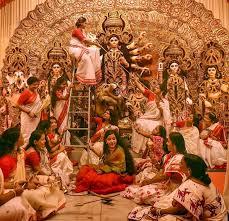Introduction: Durga Puja in Assam’s Bengali Communities
In the culturally diverse state of Assam, the Bengali community has kept the vibrant spirit of Durga Puja alive for generations, transforming it into one of the region’s most eagerly awaited and celebrated festivals. Despite being geographically distinct from Bengal’s heartland, the Assamese Bengalis have preserved their rich heritage and distinct rituals, often blending local customs to create unique, hybrid celebrations that enrich Assam’s cultural tapestry.
geographically distinct from Bengal’s heartland, the Assamese Bengalis have preserved their rich heritage and distinct rituals, often blending local customs to create unique, hybrid celebrations that enrich Assam’s cultural tapestry.
The Bengali Durga Puja in Assam, especially in districts like Dibrugarh, Guwahati, Nagaon, Silchar, and Tinsukia, represents not just religious devotion but a powerful assertion of cultural identity and community cohesion.
For detailed event schedules, community organizer contact information, and parikrama routes, immersive guides at https://www.pujo2pujo.com/ provide invaluable support to festival-goers.
Historical Roots and Community Significance
The Bengali population in Assam grew significantly during British colonial rule, especially with the tea plantation industry’s expansion. This migration planted deep cultural roots that continue to sprout vibrant expressions every year during Durga Puja. Beyond a religious observance, the festival functions as a community unifier, drawing families and friends from scattered locations.
In urban centers like Guwahati, community pujas are organized by clubs, housing societies, and cultural associations, often in rented auditoriums or community halls. Rural areas celebrate with smaller, yet deeply heartfelt neighborhood pujas.
Rituals and Festival Practices
Bengali Durga Puja in Assam mirrors the ritual framework from Bengal, with:
-
Bodhon and idol installation following classical puja rites
-
Daily offerings of anjali, accompanied by traditional dhak beats
-
Sandhi Puja with 108 lamps lighting the sacred moment
-
Sindoor Khela marking emotional farewell on Vijaya Dashami
-
Immersion (Visarjan) ceremonies in local rivers and ponds
However, some locales incorporate Assamese elements—folk music, local floral decorations, and culinary modifications—that blend seamlessly with heritage rituals.
Cultural Programs and Social Celebrations
Cultural events during the puja have grown broad and inclusive, often featuring:
-
Rabindra Sangeet concerts
-
Traditional Bengali dance
-
Theatrical plays on Durga mythology intertwined with Assamese folklore
-
Community feasts, food stalls, and pan-Bengali delicacies fused with local flavors
Social initiatives such as blood donation camps, health awareness drives, and educational charity events often accompany the festivities, reinforcing the puja’s community spirit.
Challenges and Adaptations
In a multi-ethnic state, Bengali communities often rely on collaborative intercultural dialogue to ensure harmonious celebrations. Permissions, venue sharing, and joint cultural programs foster mutual respect and vibrant cultural exchange.
Despite challenges like urbanization and geographical spread, the Assamese Bengali diaspora remains resolute in preserving Durga Puja’s sanctity and joy, often aided by platforms like https://www.pujo2pujo.com/ providing festival networking and resource sharing.
Why Bengali Durga Puja in Assam is Unique
Bengali Durga Puja in Assam offers a fascinating blend of tradition and regional diversity—a living example of cultural resilience. Here, the essence of Bengal’s goddess worship dances beautifully with Assam’s folk aesthetics, creating festivals that are intimate yet festive, historic yet fresh.
For everyone interested in exploring diverse Bengali cultural expressions across India, the Assam puja scene provides a rich, underappreciated treasure trove.




